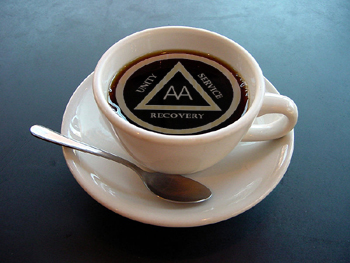|

Dutch Courage: A History
of Booze in America
(continued)
By Joan Schonbeck
Two men little affected by Prohibition had been William
Griffith Wilson and Dr. Robert Smith. Wilson was one of the "bright
young men" of Wall Street in the early '20s. For people of his
social set, obtaining booze was no problem. Dr. Smith didn't have much
trouble either. He simply wrote himself prescriptions. Most of Wilson's
drinking career occurred during Prohibition, and Smith's excesses with
drink cost him his health and practice during those same years. Both
men knew, by 1933, that continued drinking could only bring them death
or insanity.
In December 1934, Bill Wilson experienced a miracle. During
his third stay at a Brooklyn hospital to "dry out," he again
experienced terrible depression. But this time it was followed by what
he forever afterward called a "Spiritual Experience." He left
the hospital convinced that the desire to drink had left him —
FOREVER! But six months later, in an Akron, Ohio, hotel lobby, that
conviction was severely shaken as he listened to the clink of ice cubes
against glasses and the laughter of customers in the hotel's nearby
bar.
The odds of two transplanted Vermonters being brought
together in Akron, Ohio, through a phone call to a clergyman Wilson
didn't know, and then going on to found Alcoholics Anonymous, are beyond
calculation. Yet it happened. The minister, whose name Wilson found
in the hotel directory, somehow listened and understood, and suggested
he call Henrietta Sieberling, daughter-in-law of the owner of Goodyear
Rubber Corporation. It was she who also listened and understood, and
made the necessary arrangements for him to meet her good friend, Dr.
Robert Smith. From that fateful meeting, Wilson and Smith went on to
found Alcoholics Anonymous, destined to have a worldwide effect on the
treatment of alcoholism. It would also have a more lasting and powerful
impact on how Americans viewed booze than anything else that had come
before. The love affair with "John Barleycorn" wasn't over,
but it would never again be quite the same.
AA turned fifty years old with martini lunches and clandestine
teen keg parties still part of the fabric of our society. But there
was a new awareness that alcohol is a drug, and people who abuse it
addicts. Non-alcoholic beers and wines appeared, and Nancy Reagan's
"Just Say No" campaign targeted alcohol equally with other
abused substances. Increasing numbers of celebrities from sports, entertainment
and literature — people like Liza Minelli, Dodgers pitcher Bob
Welch, and writer Elmore Leonard, to name a few — went public with
their addiction and recovery and made it more socially acceptable to
admit to having a problem and getting help. "Detoxes" became
big business in the healthcare industry. Between 1978 and 1984, in-patient
for-profit substance abuse treatment programs increased a whopping 382%!
During the '80s, another, darker facet of "John Barleycorn's"
persona was beginning to anger many Americans: its ability to kill.
The following figures, culled from the National Highway Traffic Safety
Administration between 1986 and 1988, give a glimpse of its murderous
record. Someone died in an alcohol-related crash every 22 minutes in
those years. Add to this the injured, and in one year 560,000 people
were killed or injured by drunk driving — more than one per minute!
Drunk driving remains the most frequently committed crime in America
today, according to the FBI, and nearly half (41%) of all fatal crashes
involve a drunk driver.
Perhaps the most tragic part of the figures is the realization
of who "Dutch Courage" is killing and injuring. Fifty-four
percent of all children killed in automobile accidents were driving
with a drunken parent. Ninety-two percent of all high-school seniors
have used alcohol (as opposed to 47% who have used marijuana or 12%
who have used cocaine). There are 28 million children of alcoholics
in the United States today, one-quarter of whom are under the age of
eighteen. Alcohol abuse is involved in 50% of all spousal abuse cases,
49% of all murders, 68% of manslaughter cases, 62% of assaults, 52%
of rapes, and 38% of child abuse fatalities. Cirrhosis of the liver,
often caused by excessive alcohol use, is the ninth leading cause of
death in the United States. *
In 1980, in California, Candy Lightner's fourteen-year-old
daughter was run over and killed by a drunk driver. From the figures,
clearly she wasn't the only one to lose a child that way. But what Lightner
did with her anger and grief is part of the change in attitude that's
spanning the country. She formed MADD, Mothers Against Drunk Driving.
Unlike Carry Nation's WCTU ladies, MADD's primary focus has been helping
victims, the families who are put through this ordeal. They have been
instrumental in getting laws changed, in doing away with the tacit approval
drunk driving has always enjoyed here in America. A companion group,
SADD, Students Against Drunk Driving, began in Marlborough, Massachusetts,
in 1984.
It's been part of us for so long! "Dutch Courage"
accompanied us on every step we took across America, was with us to
witness every event that makes up our history. Sometimes we truly believed
it gave us courage — and maybe it did. Sometimes it enlivened our
celebrations, made us feel happy or confident. Equally, it created poverty
and crime, destroyed families, and even killed us. But no other nation
on earth, from alcohol-banning Muslim theocracies to those who have
virtually no laws against it, have ever embraced and tussled with booze
as we have. All the serious efforts to alter behavior around alcohol
— from the Washingtonians to Alcoholics Anonymous to Mothers Against
Drunk Driving — have their roots planted deeply here in the United
States. And there are more chapters yet to be written.
*National Institute on Alcohol Abuse and Alcoholism, Sixth
Special Report to Congress on Alcohol and Health, 1987.

|